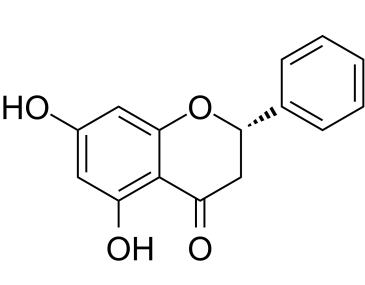Pinocembrin [(+)-Pinocoembrin; Dihydrochrysin; Galangin flavanone] is a naturally occuring flavonoid widely found in damiana, honey, fingerroot, and propolis with potent antioxidant, antimicrobial, anti-inflammatory and gastrointestinal protective effects. It acts as a competitive inhibitor of histidine decarboxylase, and is an effective anti-allergic agent.
Physicochemical Properties
| Molecular Formula | C15H12O4 |
| Molecular Weight | 256.257 |
| Exact Mass | 256.073 |
| Elemental Analysis | C, 70.31; H, 4.72; O, 24.97 |
| CAS # | 480-39-7 |
| Related CAS # | 480-39-7 |
| PubChem CID | 68071 |
| Appearance | White to yellow solid powder |
| Density | 1.4±0.1 g/cm3 |
| Boiling Point | 511.1±50.0 °C at 760 mmHg |
| Melting Point | 192 - 193 °C |
| Flash Point | 199.3±23.6 °C |
| Vapour Pressure | 0.0±1.4 mmHg at 25°C |
| Index of Refraction | 1.662 |
| LogP | 3.93 |
| Hydrogen Bond Donor Count | 2 |
| Hydrogen Bond Acceptor Count | 4 |
| Rotatable Bond Count | 1 |
| Heavy Atom Count | 19 |
| Complexity | 337 |
| Defined Atom Stereocenter Count | 1 |
| SMILES | O1C2=C([H])C(=C([H])C(=C2C(C([H])([H])[C@@]1([H])C1C([H])=C([H])C([H])=C([H])C=1[H])=O)O[H])O[H] |
| InChi Key | URFCJEUYXNAHFI-ZDUSSCGKSA-N |
| InChi Code | InChI=1S/C15H12O4/c16-10-6-11(17)15-12(18)8-13(19-14(15)7-10)9-4-2-1-3-5-9/h1-7,13,16-17H,8H2/t13-/m0/s1 |
| Chemical Name | 4H-1-Benzopyran-4-one, 2,3-dihydro-5,7-dihydroxy-2-phenyl-, (2S)- |
| Synonyms | Pinocembrin(+)-Pinocoembrin Dihydrochrysin Galangin flavanone |
| HS Tariff Code | 2934.99.9001 |
| Storage |
Powder-20°C 3 years 4°C 2 years In solvent -80°C 6 months -20°C 1 month |
| Shipping Condition | Room temperature (This product is stable at ambient temperature for a few days during ordinary shipping and time spent in Customs) |
Biological Activity
| ln Vitro |
Pinocembrin (5, 10, 25, 50, 100, or 200 µM, 24 hours) dramatically lowers RBL-2H3 cell viability[1]. At 25 or 50 µM, pinocembrin decreases iNOS, PGE-2, and COX-2 levels, raises p38-Mapk and IкB-α, and prevents IкB-α phosphorylation[1]. |
| Cell Assay |
Cell Line: RBL-2H3 cells Concentration: 5, 10, 25, 50, 100 or 200 µM Incubation Time: 24 hours Result:50% less cells viable at concentrations of ≥ 100 µM. demonstrated 75% cell viability at reduced dosages. |
| References |
[1]. Hanieh\nH, et al. Pinocembrin, a novel histidine decarboxylase inhibitor with\nanti-allergic potential in in vitro. Eur J Pharmacol. 2017 Nov\n5;814:178-186. [2]. Chen Y, Wang K. Pinocembrin Protects Against Dextran Sulfate Sodium-Induced Rats Colitis by Ameliorating Inflammation, Improving Barrier Function and Modulating Gut Microbiota. Front Physiol. 2019 Jul 19;10:908. |
| Additional Infomation |
Pinocembrin is a dihydroxyflavanone in which the two hydroxy groups are located at positions 5 and 7. A natural product found in Piper sarmentosum and Cryptocarya chartacea. It has a role as an antioxidant, an antineoplastic agent, a vasodilator agent, a neuroprotective agent and a metabolite. It is a dihydroxyflavanone and a (2S)-flavan-4-one. Pinocembrin has been reported in Apis, Populus yunnanensis, and other organisms with data available. |
Solubility Data
| Solubility (In Vitro) |
DMSO : 51~83.33 mg/mL (199.02~325.19 mM) Ethanol : ~51 mg/mL |
| Solubility (In Vivo) |
Solubility in Formulation 1: ≥ 2.08 mg/mL (8.12 mM) (saturation unknown) in 10% DMSO + 40% PEG300 + 5% Tween80 + 45% Saline (add these co-solvents sequentially from left to right, and one by one), clear solution. For example, if 1 mL of working solution is to be prepared, you can add 100 μL of 20.8 mg/mL clear DMSO stock solution to 400 μL PEG300 and mix evenly; then add 50 μL Tween-80 to the above solution and mix evenly; then add 450 μL normal saline to adjust the volume to 1 mL. Preparation of saline: Dissolve 0.9 g of sodium chloride in 100 mL ddH₂ O to obtain a clear solution. Solubility in Formulation 2: ≥ 2.08 mg/mL (8.12 mM) (saturation unknown) in 10% DMSO + 90% (20% SBE-β-CD in Saline) (add these co-solvents sequentially from left to right, and one by one), clear solution. For example, if 1 mL of working solution is to be prepared, you can add 100 μL of 20.8 mg/mL clear DMSO stock solution to 900 μL of 20% SBE-β-CD physiological saline solution and mix evenly. Preparation of 20% SBE-β-CD in Saline (4°C,1 week): Dissolve 2 g SBE-β-CD in 10 mL saline to obtain a clear solution. Solubility in Formulation 3: ≥ 2.08 mg/mL (8.12 mM) (saturation unknown) in 10% DMSO + 90% Corn Oil (add these co-solvents sequentially from left to right, and one by one), clear solution. For example, if 1 mL of working solution is to be prepared, you can add 100 μL of 20.8 mg/mL clear DMSO stock solution to 900 μL of corn oil and mix evenly. Solubility in Formulation 4: 10% DMSO+40% PEG300+5% Tween-80+45% Saline: ≥ 2.08 mg/mL (8.12 mM) (Please use freshly prepared in vivo formulations for optimal results.) |
| Preparing Stock Solutions | 1 mg | 5 mg | 10 mg | |
| 1 mM | 3.9023 mL | 19.5114 mL | 39.0229 mL | |
| 5 mM | 0.7805 mL | 3.9023 mL | 7.8046 mL | |
| 10 mM | 0.3902 mL | 1.9511 mL | 3.9023 mL |
